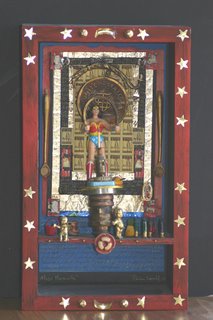 Forbidden Fruit, Laura Murphy
Forbidden Fruit, Laura Murphy
Laura Murphy still recalls the day she learned about the metamorphosis of a caterpillar into a butterfly. "There's a phase in the middle where there is nothing but goo left in the chrysalis. The butterfly literally rebuilds itself from complete disintegration."
Rebuilding is at the heart of Murphy's work -- her passion lies in recycling old and discarded materials, "participating in a cycle of death and renewal." Her best works reflect that passion. The sculpture "Tree Book" rises tremulously from its base, ruffled pages of a book sprouting airy willow branches. Low-fire ceramic, natural materials and dye, papier mache and handmade, denim paper make up the work, one of her most outspoken environmental statements.
As statements go, it's more of a gentle reminder -- a hint that we might do well to think carefully about all the consumption around us. This gentle touch runs through all of Murphy's work: goddess paintings celebrate the innocuous rituals of planting and marking the changing of the seasons. But there is a harder truth to tell here, as well. Murphy's paintings flow with multiple folds of flesh -- her unflinching depictions of unsettlingly large women with androgynous faces explore an alternative beauty beyond the tucked and brushed ideal of a goddess in our society. These straightforward, full-frontal shots of women in their imperfect bodies hark to the devastatingly honest portraits of Alice Neel. At the same time, soft, earthy colors and dreamy lines lend grace to figures typically associated with awkwardness in our society.
Her sculptures and installations share that same sense of ease. "Seed Bowl" honors the quiet, easy perfection of nature -- muted colors and graceful curves display a complex geometric pattern of arranged bowl-gourd seeds. Her "abc" series of garden installations also served as maquettes for a larger project tentatively scheduled with the US Forest Service. Clusters of hungry-looking clay cones crowd together, vaguely reminiscent of an unruly bouquet of calla lilies. The material is unglazed and raw -- it is designed to break down over time, bending to the will of nature, until, at last, carefully placed seeds sprout and take hold. Plants chosen for their hardiness and environmental benefits stand in the wake of the collapsed, woman-made structure.
The contrast between delicate vulnerability and the unrelenting power of nature is an arching theme in Murphy's work. It is a perennial question with roots in various women's movements; the issue finds expression both in her movement between fine art and traditional women's crafts, and in her driven commitment to community involvement. Murphy wears a stack of weighty hats: she serves as the assistant gallery director and an art instructor at Adams State College, organizes and participates in a variety of online and real-time arts forums, and volunteers for worthy causes as diverse as poverty and capital punishment.
That collaborative, inclusive approach to art making -- and to living -- channels much of the power of Judy Chicago's work. Chicago knew that a woman committed to honoring the feminine in our society has her work cut out for her, and Murphy has proven she's up to the challenge. The balance between hard work and peaceful healing -- power and vulnerability -- must grow from the ashes of old understandings. Like changing into a butterfly, the process requires the faith to break down into nothing; the most remarkable quality of Murphy's work is the clarity within that balance.
Send questions about IAC or any featured artists, or visit insightartconnection.com to see more work!







